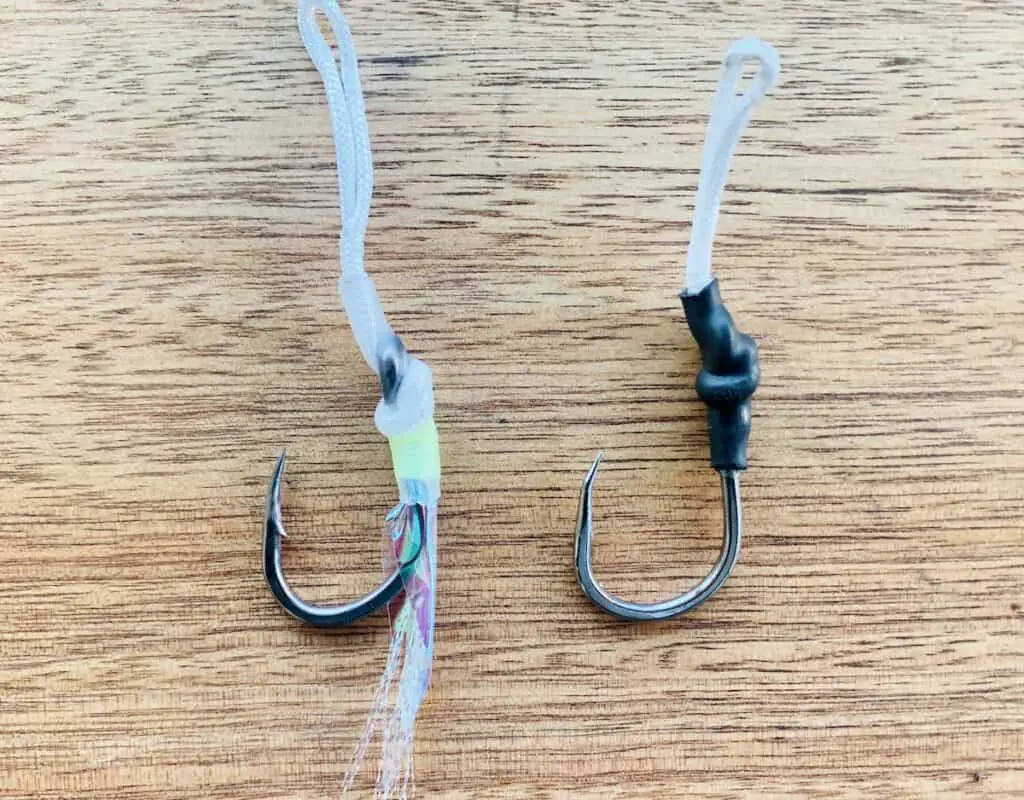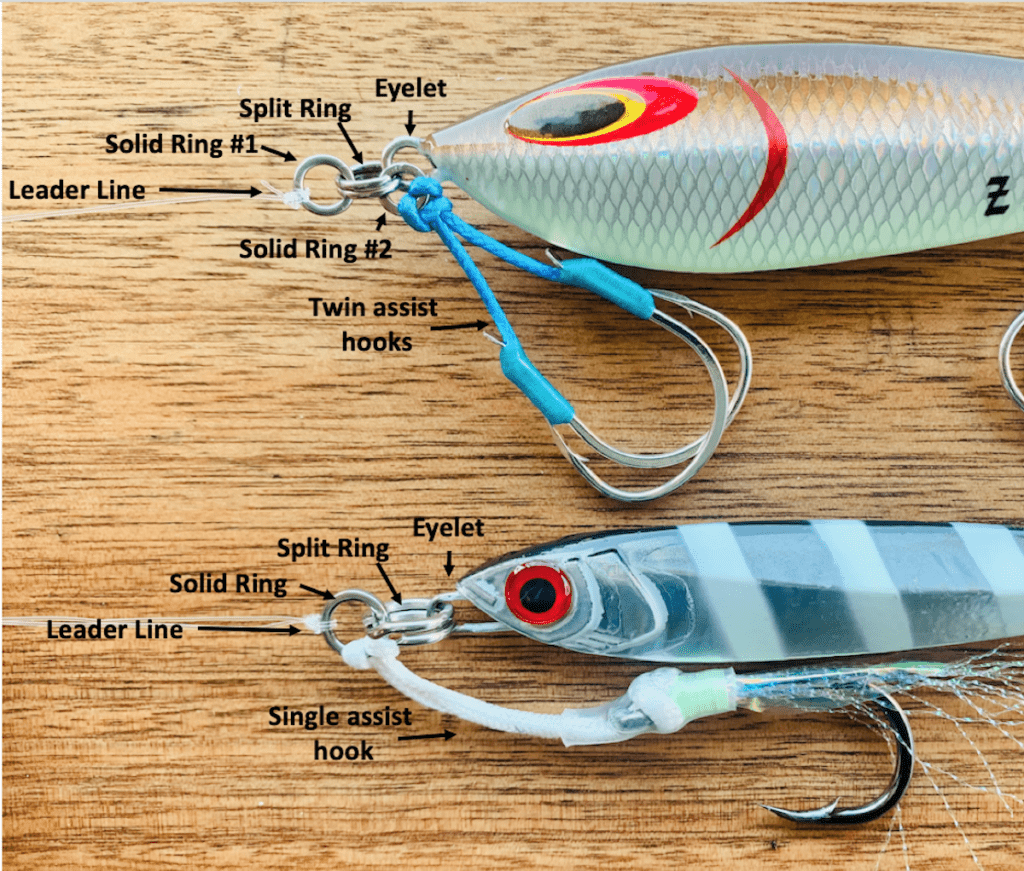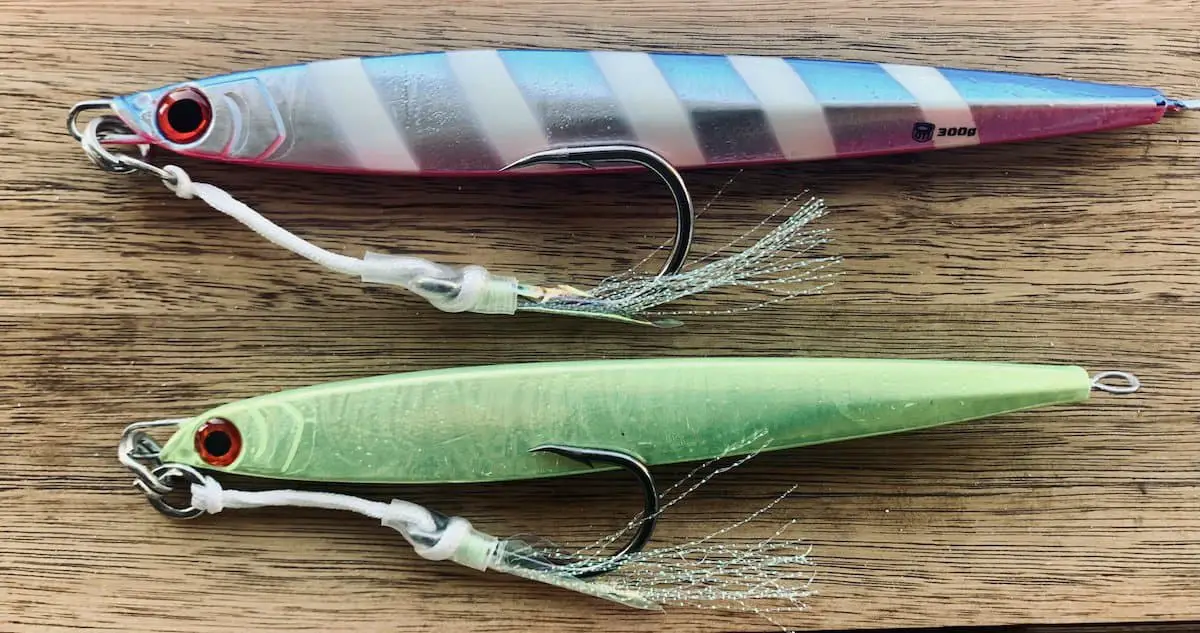What is a Vertical Jig?
A vertical jig is fishing lure designed to fall quickly to the ocean floor and then dart erratically on the retrieve. The action of the jig is intended to mimic a fast fleeing baitfish. These jigs are heavy and slender to reach the bottom quickly. They are normally pre-rigged with heavy gauge hooks to withstand a hard strike from a fast-moving pelagic fish. These jigs are painted with flashy and luminous color to further attract fish.
Vertical jigs should be used with a high speed vertical jigging technique. In this technique, the lure drops to the bottom quickly and then is jerked and retrieved on the way up. The jigs are designed in such a way that they dart in the water as they’re retrieved up. Anglers will use a variety of twitch and retrieve patterns to vary the pause time and direction of the darting.
A few examples of vertical jigs are Ocean Tackle International Ricochet jig, and the Ocean Tackle International Degen jig. The Degen jig is versatile enough to use for both slow pitch jigging and high speed vertical jigging. It’s always a good idea to keep a variety of jigs on hand. This way you can change it up to get a strike.
When choosing the size of jig to use, the best estimate is 100 grams per every 100 feet of water. However, this is a first estimate and you may find you need a heavier jig when the current is strong. You’ll want the jig to fall as straight down as possible. You’ll also want the jig to be heavy enough to prevent slack in the line on the fall.
How to Work a Vertical Jig
A vertical jig is worked straight up and down with a twitch and retrieve, and then a pause. The jigs will dart erratically, imitating a fleeing baitfish. The speed of the action is critical. The twitching and retrieving must be fast. For this reason, high speed vertical jigging can be exhausting for the angler.
Unlike slow pitch jigging, there should be no slack in the line when working the jig. The jigs are designed to attract fish when being retrieved, not when falling.
There are tons of twitch, jerk, pause, retrieve patterns you can use. Part of the enjoyment of vertical speed jigging comes from exploring different patterns and different jigs. You may find that when targeting tuna, you like to retrieve and jerk for 30 feet before you do a pause. Next time you go out, try a few different patterns, giving each one a reasonable amount of time, and see which works best for you.
Hooks for Vertical Jigs
Heavy gauge hooks are best when vertical speed jigging. Heavy gauge hooks are thicker and more difficult to penetrate the mouth of a fish, however, the force from the fast retrieve and the downward weight of the jig prevents this from being an issue. If too light of a gauge hook were used, there would be a serious risk of hook bending because of the force from the rapid retrieve.
The hook size is also an important feature to consider. The hook should the largest possible hook while still maintaining that the jig is wider than the hook. This will ensure that if the jig is struck, the hook is capable of fitting in the fish’s mouth as well.

The cord length is also important. The bottom of the hook should hit about midway down the jig. This sometimes makes it difficult to find hooks to buy. There’s a variety of assist hooks on the market, but the keeping a variety of hook sizes and a variety of cord lengths adds up to a lot of hooks to keep on hand.
If the cord is too short, you risk missing the fish for a short strike. You can avoid this by using a cord long enough for the hook to reach to the midpoint of the jig, or you can avoid it by putting an additional assist hook on the bottom eyelet. Both are reasonable methods of rigging hooks.
How to Rig a Vertical Jig
Vertical jigs are rigged with assist hooks, however there are a few important distinctions between speed jig rigging and slow pitch jig rigging.
With vertical speed jigs, the hooks should be heavy gauge and tend to be single hooks. Slow pitch jigs can either be rigged with single hooks or, commonly, twin light wire assist hooks.
When rigging for vertical speed jigging, the leader is attached to a solid ring which holds the heavy gauge single hook. The jig is then attached to that solid ring using a split ring. In the case of vertical speed jigging, the solid ring is the main junction point of the rig.
When rigging for slow pitch jigging, most often the leader is attached to a solid ring which is then attached to a split ring. The split ring is then attached to another solid ring that holds the twin assist hooks and the split ring is also attached to the top eyelet of the jig. In the case of slow pitch jigging, the split ring is the main junction point of the rig. To learn more about slow pitch jigs, read my article on it, here.

Experienced anglers will sometimes warn against the split ring being a primary point in the setup. Split rings can open up and there is potential to lose a jig and/or fish because of it. It’s important to understand that the reason the rigging is different in these two types of jigging is because of the difference in strike.
The strike of a fish when vertical speed jigging is a hard, reactionary strike because the jig is imitating a fleeing and healthy baitfish. The strike of a fish when slow pitch jigging is a much softer, convenience strike because the jig is imitating a dying baitfish. The risk of a split ring opening up is much greater when vertical speed jigging, so the hook to solid ring to leader chain eliminates the chances of losing a fish (you may lose a jig though!). My article Speed Jigging vs Slow Jigging: Is Speed the Only Difference? talks about the differences in the types of jigging in detail.
I hope this article helped you understand what a vertical jig is and how to use it. Tight lines, y'all!
Recent Posts
Fat Cow Jig Strips: The Ultimate Bucktail Jig Upgrade for Surf Fishing
As discussed in my previous article, "Surf Fishing with Bucktail Jigs: Ultimate Guide for Beach Anglers," bucktail jigs are a staple in any surf angler's tackle box, offering a versatile way to catch...
In my previous article, "Surf Fishing with Bucktail Jigs: Ultimate Guide for Beach Anglers," I introduced you to the bucktail jig and discussed how versatile of a lure it is for catching a wide range...

